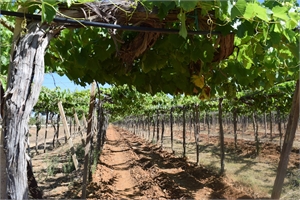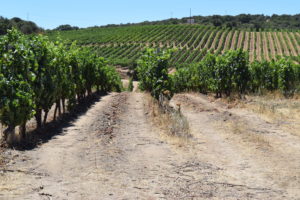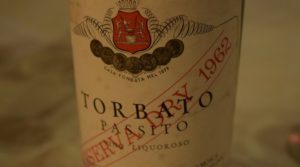Story and photos by Roger Morris
Sella & Mosca is one of the oldest and most-respected commercial wineries in Sardinia, and its home vineyard – spread across a flat plain outside of Alghero that was once swampland – stakes a claim of being the second largest contiguous plot of wine grapes in Europe, totaling more than 1,200 acres.
Yet when the estate’s general director, Gian Matteo Baldi, decided to invite a small group of American writers to visit the sprawling estate in the island’s northwest corner, he first led them on a circuitous journey, crisscrossing the island with stops in Sulcis, Ogliastra, Barbagia and Gallura, Sardinia’s four other major wine regions, to meet small local winegrowers, listen to their stories and sample their hospitality and home-made wines.
At the end of the week, Baldi’s tour, co-sponsored by Palm Bay, Sella & Mosca’s American importer, had provided an instructive glimpse into Sardinia’s contrasting diversity in geography, culture and winemaking.

Sardinia is certainly an ideal land for winemaking, with its moderating Mediterranean climate, mostly sunny weather and refreshing winds that discourage fungal diseases, and plenty of available vineyard land, ranging from flat plains to mountainside terraces. Yet its production is less than two per cent of Italy’s total, yielding seven times less wine than the country’s other large island, Sicily, even though the two are almost exactly the same in area.
In many ways, Sardinia reminds one of the scattered appellations of Southwest France in the great number of native and forgotten-elsewhere grapes that are nevertheless still kings of their small-appellation domains. Where else would you have DOC’s devoted solely to Nuragus, Monica, Giro, Malvasia and Nasca varieties? While Sardinia has only one DOCG – Vermentino di Gallura – it boasts of 19 DOC’s and 15 IGT’s, more than any other region of Italy.
Yet, in other ways, Sardinia is like Catalonian Spain, which once ruled the region, and both of which still strong rely on the same two red grapes – Carignano (Cariñena) and Cannonau (Garnacha). In some regions, the second language is Catalan, as is reflected in the street signs in Alghero.
Finally, even though it is surrounded by the sea, Sardinia’s signature dishes are various iterations of lamb, including a grilled sausage composed of lamb intestines stuffed inside of more lamb intestines.
All of these contrasting influences are reflected in the wines, which are well-represented on the U.S. market through a large number of importers. “Sardinia has great potential for producing great wines,” says Umberto Trombelli, winemaker at Agricola Punica, whose wines are distributed in the U.S. by Kobrand. “In the last 20 years, Sardinia has decreased the gap in production quite a lot compared to other ‘noble’ Italian wine regions. As a matter of fact, the numbers of wineries, or simply wine producers, since the beginning of this century has remarkably increased, with each of them trying to offer products based on the local varietals.”
Perhaps the best way of surveying the Sardinian vast “winescape” is to start with its grape varieties.
The best known of these varieties in the American market is probably Cannonau. One reason is that one of Cannonau’s major growing regions is in the eastern mountains of Ogliastra, which has been dubbed one of the few “blue zones” of longevity around the world. Here residents often live to be 100, and Cannonau is often given credit. Cannonau also has a good backstory, as there is a debate as to whether the conquering Catalonians brought the grape from Spain – or took it back with them, as locals proclaim. Either way, says Ian Downey, senior vice president of Winebow’s Leonardo LoCasio division, “Its history and uniqueness deserve to be celebrated and shared.” Winebow imports the Argiolas line of Sardinian wines, which includes both Cannonau and Cannonau riserva.
Unlike most producers, Sella & Mosca owns Cannonau vineyards or buys Cannonau grapes from most regions of the island, including Sulcis, Ogliastra, Barbagia and Alghero.Still, Cannonau has not fully reached its full potential, according to Joseph D’Arienzo, a vice president of business and wine sales at Frederick Wildman which imports the Contni brand. “Cannonau has struggled mostly because the flavor profile does not necessarily lend itself to ‘classic’ islands reds,” he says.
If Cannonau rules Sardinia’s north and northeast, Carignano stakes its claims to the southern part of the island around Sulcis and Cagliari. “Carignano needs a lot of sunlight to reach the correct ripeness,” says Punica’s Trombelli. “The grapes take the whole summer season with its intense daylight to get this varietal to the desired ripeness. The soil composition is Sulcis is calcareous, clay, sandy which also contributes to [the quality of] a Carignan.”

Surprisingly, it is a white grape – Vermentino – that has the island’s only DOCG, Vermentino di Gallura, although the granting of additional DOCG’s seems just a matter of time. “The Mistral wind, which comes across the Mediterranean from the Rhone Valley, helps keep the grapes disease-free,” says Sella & Mosca’s Baldi, which has 15 hectares (37 acres) of 30-year-old vines in windswept Gallura.
“With Italian ‘other white grapes’ thriving in the U.S. market, Vermentino has become a really strong category,” says Winebow’s Downey. “It offers expressiveness and regionality, while being grown in areas that keep the price humble in the market.”
Two of the more interesting of the “lesser” grapes are Torbato and Bovale Sardo. Torbato is related to Tourbot in the south of France, but Sella and Mosca is the exclusive grower in Sardinia and is credited with saving the variety from extinction some years ago. It is an expressive grape with lots of skin flavor, so S&M makes dry versions, a long-aging passito and a refreshing sparkling wine. Ariolas makes a red blend called “Korem” that is mainly Bovale, believed related to Spain’s Graciano, and which sells well in the U.S.

Another variety, Vernaccia, is made into a sweet wine as Vernaccia di Oristano. D’Arienzo explains that Wildman’s Contini Vernaccia involves the use of flor to make “a Sherry-like wine.” Other grapes used both as varietals and in blends including Malvasia, Moscato, Monica, Nauragus, Giro and Nasca. Of course, there are plantings of international varieties, especially the Bordeaux reds, which are often used in blends.
Among other major producers and are importers include Santadi (Empson), Mesa (Montcalm), Catasetta (Siena) and Capichera (International Cellars).
“The one thing we want to do,” Baldi said at the end of his tour, “is to keep our biodiversity in Sardinian winemaking.” From all outward appearances, that goal seems at present to be well protected.
The Appellations of Sardinia
Sardinia DOCG:
Vermentino di Gallura or Sardegna Vermentino di Gallura
Sardinia DOCs:
Alghero or Sardegna Alghero, Arborea or Sardegna Arborea, Campidano di Terralba or Terralba or Sardegna Campidano di Terralba or Sardegna Terralba, Cannonau di Sardegna, Carignano del Sulcis or Sardegna Carignano del Sulcis, Girò di Cagliari or Sardegna Girò di Cagliari, Malvasia di Bosa or Sardegna Malvasia di Bosa, Malvasia di Cagliari or Sardegna Malvasia di Cagliari, Mandrolisai or Sardegna Mandrolisai, Monica di Cagliari or Sardegna Monica di Cagliari, Monica di Sardegna, Moscato di Cagliari or Sardegna Moscato di Cagliari, Moscato di Sardegna, Moscato di Sorso-Sennori or Moscato di Sorso or Moscato di Sennori or Sardegna Moscato di Sorso-Sennori or Sardegna Moscato di Sorso or Sardegna Moscato di Sennori, Nasco di Cagliari or Sardegna Nasco di Cagliari, Nuragus di Cagliari or Sardegna Nuragus di Cagliari, Sardegna Semidano, Vermentino di Sardegna, Vernaccia di Oristano or Sardegna Vernaccia di Oristano
Sardinia IGTs:
Barbagia, Colli del Limbara, Isola dei Nuraghi, Marmilla, Nurra, Ogliastra, Parteolla, Planargia, Provincia di Nuoro, Romangia, Sibiola, Tharros, Trexenta, Valle del Tirso, Valli di Porto Pino
